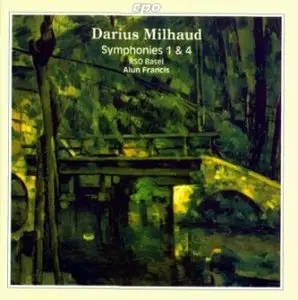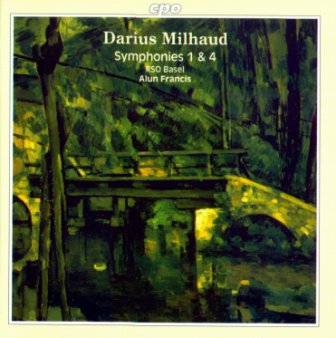Darius Milhaud - Symphony No. 1 op. 210 and Symphony No. 4 op. 281 (RSB/Francis)
Classical | EAC: FLAC+Cue+Log | 1 Cd, Covers + Booklet | 278 Mb
Date: 1998
Classical | EAC: FLAC+Cue+Log | 1 Cd, Covers + Booklet | 278 Mb
Date: 1998
Darius Milhaud evidently planned his musical career on a long-term basis. In 1920 he announced that he would write eighteen string quartets in his life, and he did so, completing his last quartet in 1951. Milhaud said that he did not plan on writing symphonies until 1942 (when he would be fifty years old), but that when a commission came in for a symphonic work to mark the fiftieth anniversary of the Chicago Symphony Orchestra, he judged that he was ready, and accepted the commission. Symphony No. 1 was the result.Tracks:
The main motivation for Milhaud's time frame was a desire for time to master the problem of using polytonality in larger forms and ensembles. Polytonality is the practice of using more than one distinct key at the same time, and is a major aspect of Milhaud's style. His problem was, first, to keep the competing tonal centers clear (rather than letting the tonality become obscured and collapse into atonality). Another problem was that the resulting dissonances generated a lot of overtones, which had the potential to create a muddy orchestral texture. Milhaud therefore for the most part avoided full-sized ensembles in his instrumental music to this point in his life.
The opening movement is based on two themes. The first is for flute and violins, while the other first appears in the woodwinds. The composer hoped to express "a great feeling for nature"; in the opinion of Aaron Copland this quiet and melodic movement had a "tender and nostalgic sensuousness." The second movement, with three subjects, is "rather dramatic and robust, with a fugue in the middle" (the composer's description again); Copland refers to a "violent dramatic and almost brutal mood."
The third movement is tranquil, with an expressive chorale theme. The final movement is relaxed, bright, and happy, with three principal themes.
In the end, accepting the commission likely saved Milhaud's life. Just as World War II broke out in 1939 Milhaud was invited to attend the symphony's premiere in Chicago. He booked passage for himself, his wife, and their son, and thus had a way out of France as the Nazis advanced.
When Milhaud returned to France after eight years of wartime exile in the United States, he did so on a freighter from San Francisco to Le Havre, passing through the Panama Canal. The trip took 41 days. Milhaud occupied himself on board by composing his symphony No. 4, which was commissioned by the French government to be part of the centenary observance of the Revolution of 1848, which established the Second Republic. The premiere was on French Radio, on May 20, 1948. Roger Desormière, who was to have conducted, fell ill, so Milhaud led the performance himself.
This is the only symphony by Milhaud with a direct historical program. Milhaud enjoyed polyphonic textures (using many separate lines at once) and in the first movement used this technique to represent many individuals who come together to make a common movement. Their melodic material is a plethora of folk-style themes, or fragments of themes, all mixed and woven together. They ultimately coalesce in a joyful statement.
The second movement is en elegy to those who fell to establish the republic. Milhaud limits his orchestral resources here and crates an effect of both intimacy and lamentation.
Milhaud seemingly associated joy with a pastoral setting, and expresses this joy for the country in a movement that alternates between such a portrayal and a more noble statement of triumph, but expressed in personal, intimate feelings.
The public commemoration comes in the final movement, where some of the main popular themes of the first movement and the more heroic music they became are restated and then put through a process of expansion, a statement of hope for the future.
01. No.1 / I. Pastroral. Moderement anime [0:07:13.40]
02. No.1 / II. Tres vif [0:04:38.53]
03. No.1 / III. Tres modere [0:06:35.57]
04. No.1 / IV. Fnal. Anime [0:06:31.50]
05. No.4 / I. L'insurrection. Anime [0:05:05.13]
06. No.4 / II. Aux Morts de la Republique. Lent [0:13:02.42]
07. No.4 / III. Les Joies de la Liberte retrouvee. Moderement anime [0:05:04.23]
08. No.4 / IV. Commemoration 1948. Final. Anime [0:05:14.70]
Exact Audio Copy V1.0 beta 3 from 29. August 2011
EAC extraction logfile from 3. October 2013, 23:55
Darius Milhaud / Symphony No. 1 op. 210 and Symphony No. 4 op. 281 (RSB/Francis)
Used drive : TSSTcorpCDDVDW SH-S223C Adapter: 2 ID: 1
Read mode : Secure
Utilize accurate stream : Yes
Defeat audio cache : Yes
Make use of C2 pointers : No
Read offset correction : 697
Overread into Lead-In and Lead-Out : No
Fill up missing offset samples with silence : Yes
Delete leading and trailing silent blocks : No
Null samples used in CRC calculations : Yes
Used interface : Native Win32 interface for Win NT & 2000
Used output format : User Defined Encoder
Selected bitrate : 896 kBit/s
Quality : High
Add ID3 tag : No
Command line compressor : C:\Program Files (x86)\Exact Audio Copy\FLAC\FLAC.EXE
Additional command line options : -V -0 -T "COMMENT=Ripped by Tapaz9" -T "artist=%artist%" -T "title=%title%" -T "album=%albumtitle%" -T "date=%year%" -T "tracknumber=%tracknr%" -T "genre=%genre%" %source%
TOC of the extracted CD
Track | Start | Length | Start sector | End sector
––––––––––––––––––––––––––––-
1 | 0:00.32 | 7:13.40 | 32 | 32546
2 | 7:13.72 | 4:38.53 | 32547 | 53449
3 | 11:52.50 | 6:35.57 | 53450 | 83131
4 | 18:28.32 | 6:31.50 | 83132 | 112506
5 | 25:00.07 | 5:05.13 | 112507 | 135394
6 | 30:05.20 | 13:02.42 | 135395 | 194086
7 | 43:07.62 | 5:04.23 | 194087 | 216909
8 | 48:12.10 | 5:14.70 | 216910 | 240529
Range status and errors
Selected range
Filename F:\Musique\Milhaud, Darius\Milhaud_Symphonies1and4\Darius Milhaud - Symphony No. 1 op. 210 and Symphony No. 4 op. 281 (RSB,Francis).wav
Peak level 97.7 %
Extraction speed 12.7 X
Range quality 100.0 %
Copy CRC 2D85F2ED
Copy OK
No errors occurred
End of status report
==== Log checksum FC712550DD6A591C6ED0F8CC909A8B146BD7CCEF36693CCD8A926D36EF15A07F ====



